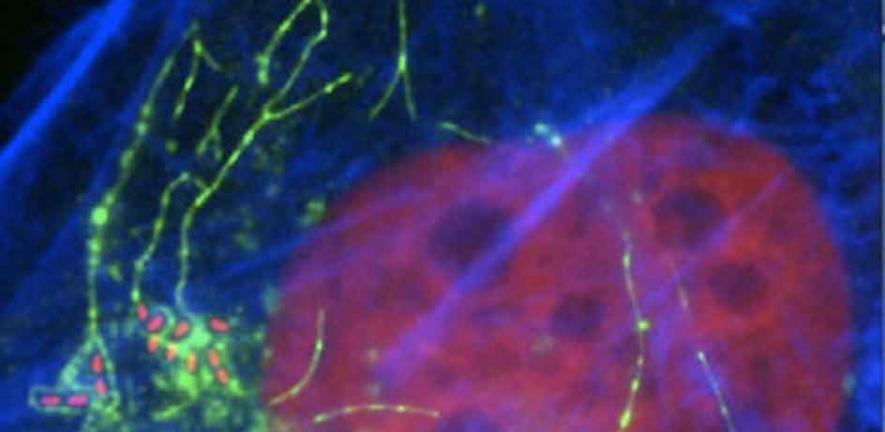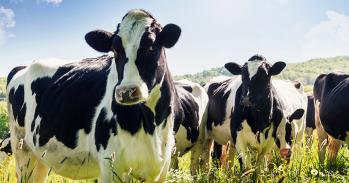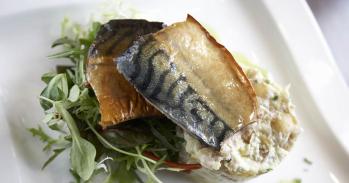
The discovery of an elusive pump component opens up new avenues to understand and combat multidrug-resistant bacteria.
The discovery of an elusive pump component opens up new avenues to understand and combat multidrug-resistant bacteria.
Without this missing link, it has not been possible to take the next step – assembling the entire pump.
Professor Vassilis Koronakis
Drug resistance in bacteria is a grave and increasing threat as it undermines antibiotic treatment of infectious diseases in humans and animals. A major cause of resistance in bacteria such as Salmonella, Escherichia coli and Pseudomonas is the existence of pumps in the bacterial cell membrane – as quickly as antibiotics enter, they are pumped back out of the cell before the bacteria are killed. What’s more, these so-called multidrug efflux pumps can transport many different antibiotics, so the bacteria can become resistant to a great many drugs at the same time.
To understand the action of these pumps, it is essential to establish their molecular structure. For two decades, the research group of Professors Vassilis Koronakis and Colin Hughes in the Department of Pathology has been combining crystallography, biochemistry and biophysics to painstakingly elucidate how the components function and interact. But one piece of the jigsaw has remained elusive.
‘Without this missing link,’ explained Professor Koronakis, ‘it has not been possible to take the next step – assembling the entire pump.’ Now Dr Martyn Symmons, holding a University Oppenheimer Research Fellowship in the Koronakis/Hughes group, has unearthed the final piece in the pump jigsaw. Published this week in the journal Proceedings of the National Academy of Sciences (USA), the research describes the structure of the pump, which comprises three protein components that assemble to span both the membranes of the bacterial cell. Using chemical crosslinking experiments that build on their previous structural findings, the researchers identified the protein–protein interactions that underlie assembly of the active pump and have visualised the first data-driven model of the complete tripartite efflux pump spanning the entire bacterial cell envelope from inside to outside.
‘The work gives us a clearer view of how antibiotics and other drugs are ejected from the cell,’ explained Professor Koronakis. ‘We hope that it will strengthen development of strategies against multidrug-resistant bacteria by opening the way to the design of novel chemotherapeutic agents that counteract the pumps.’
For more information, please contact Professor Vassilis Koronakis (vk103@cam.ac.uk) or Dr Martyn Symmons (mfs@mole.bio.cam.ac.uk). This work was funded by the Wellcome Trust and the Cambridge Oppenheimer Research Fund and is published in Proc Natl Acad Sci (USA) (2009) 106, 6893-6894
Figure legend: The assembled multidrug efflux pump spans the entire bacterial cell envelope (both inner and outer membranes and intervening periplasmic space), enabling it to pump harmful antibiotics from inside the bacterium out into the environment.
Progress towards the assembled drug efflux pump
Koronakis V, Sharff A, Koronakis E, Luisi B and Hughes C (2000) Crystal structure of the bacterial membrane protein TolC central to multidrug efflux and protein export. Nature 405, 914–919
Andersen C, Koronakis E, Bokma E, Eswaran J, Hughes C and Koronakis V (2002) Transition to the open state of the TolC periplasmic tunnel entrance. Proceedings of the National Academy of Sciences (USA) 99, 11103–11108
Higgins M, Bokma E, Koronakis, E, Hughes C and Koronakis V (2004) Structure of the periplasmic component of a bacterial antibiotic efflux pump. Proceedings of the National Academy of Sciences (USA) 101, 9994–9999
Lobedanz S, Bokma E, Symmons MF, Koronakis E, Hughes C and Koronakis V (2007) A periplasmic coiled-coil interface underlying TolC recruitment and the assembly of bacterial drug efflux pumps. Proceedings of the National Academy of Sciences (USA) 104, 4612–4617
Symmons MF, Koronakis E, Bokma E, Hughes C and Koronakis V (2009) The assembled structure of a complete tripartite bacterial multidrug efflux pump. Proceedings of the National Academy of Sciences (USA) 106, 6893-6894
This work is licensed under a Creative Commons Licence. If you use this content on your site please link back to this page.





